* En Aldao, Juan Pablo (2016). La Planificación Prospectiva Estratégica como medio para el Posicionamiento Institucional. Caso: Asociación Latinoamericana de Jueces del Trabajo. Período 2013-2015. Proyecto de graduación para el grado de Ciencias Políticas y Administración Pública, supervisado por Ana Da Viá y Javier Vitale.
ABSTRACT
This article is based on the crucial question of how to build a scenario of strategic institutional positioning of Asociación Latinoamericana de Jueces del Trabajo (Latin American Association of Labor Judges, hereinafter referred to as ALJT by its acronym in Spanish) for 2020. Taking into account this aim, a strategic foresight study with a participative perspective was carried out in order to encourage reflection, debate and social construction of the Association. On the other hand, a SWOT analysis with medium-term and long-term future vision was performed through the implementation of face-to-face and virtual workshops as well as a remote survey to identify the perception of the members. The main results were the “forward-looking scenario» for 2020 and a proposal for a vision, a mission, goals, strategies and courses of action, with the purpose of guiding decisions to be taken in the present and calling for joint initiatives to build the desired future.
INTRODUCTION
Complexity, interdependence, intrinsic uncertainty of the future, and acceleration of change affect organizations by building a volatile, uncertain, complex and ambiguous reality that places the organizations themselves in a vulnerable condition. In this context scenario planning is presented as an approach that allows organizational managers to guide the participative construction of contexts and favorable changes, trying to reduce the degree of risk in decision making and facilitating a less complex and proactive Time to take action in the present.
Following the previous point, the ALJT was seen as an opportunity not yet sufficiently explored in terms of the formulation and implementation of a scenario-based planning process that would allow it to position itself at the regional and global levels as a reference in the field of labor law and, on the other hand, to adapt the strategies to this end, including the communication.

Source: ALDAO, Juan Pablo, La Planificación Prospectiva Estratégica como medio para el Posicionamiento Institucional. Caso: Asociación Latinoamericana de Jueces del Trabajo. Período 2013-2015.
It is worth defining some key concepts that will be present throughout this paper. First, according to Souza Silva, institutional sustainability involves “acknowledgement and political, institutional and financial support attained by an organization as a result of a constant interaction and negotiation process with the key agents of its relevant context” (SOUZA SILVA; 2001:37).
Second, institutional positioning is the place an organization takes in a specific context, in comparison to other similar organizations competing with the same products or services and from which the organization attempts to differentiate (ESCUELA DE ADMINISTRACIÓN PÚBLICA DE MÉXICO; 2016).
It is also relevant to define, according to Dess and Lumpkin, strategic planning consists of “the analysis, decisions and actions an organization undertakes in order to create and sustain comparative advantage over the years”. Moreover, strategic planning aids in the design of a strategy based on the current positioning and the target positioning (MARTÍNEZ PEDRÓS and MILLA GUTIÉRREZ; 2005: 9).
Finally, foresight, which is considered as the discipline that allows us to visualize and analyze the impact of social changes over time, based on present information (MEDINA VÁSQUEZ and ORTEGÓN; 2006: 149). By means of this information, the agent tries to reduce the environmental uncertainty in which the organization converges so as to carry out necessary strategic actions to reach the target goal.
Having defined the key concepts for this study, it must be pointed out that the aim is to suggest scenarios for 2020 so that ALJT can perform strategic actions to attain its desired positioning, providing a model for regional and worldwide labor issues.
In order to do so, the study was divided into the following stages:
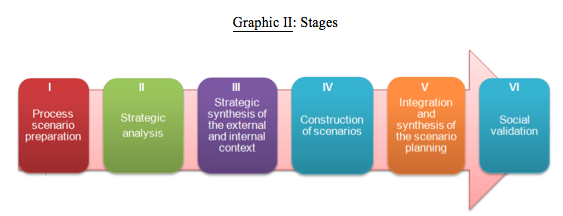
Source: ALDAO, Juan Pablo, La Planificación Prospectiva Estratégica como medio para el Posicionamiento Institucional. Caso: Asociación Latinoamericana de Jueces del Trabajo. Período 2013-2015.
Process scenario preparation
Prior to describe the first stage in the process of scenario planning, it is relevant to outline the methodology used, which consisted of doing face-to-face and virtual workshops, as well as surveys aimed at collecting labor law related information from the different parties involved.
Therefore, the following groups of participants were established:
- Technical team: in charge of Lic. Javier Vitale, Lic. Juan Pablo Aldao and Carolina Castro, whose responsibility was the methodological planning and the systematization of the information acquired in the workshops.
- Reduced forum: integrated by ALJT staff (7 members), who participated in all the activities and provided political support to carry out the project. Likewise, they supplied information, criteria and documents to form the theoretical background of the activities.
- General forum: integrated by key agents in the field of Latin American labor law (21 members), who took part in the activities, facilitating legal criteria and varied points of view according to the different realities in their countries.
The virtual participation methodology was a new way of getting collective information and exchanging it constantly during all the planning process.
After going in depth into the first stage, it was imperative to analyze and evaluate political, technical and economic viability for the implementation and development of the activity, including contextual delimitation and focalization of the organization.
The object of study was defined and the forethought of the plan, which is the preparation and planning of the social construction of knowledge in order to carry out the plan, was elaborated. Due to the fact that the members live in different places, a virtual communication strategy was mandatory, therefore, several Information and Communication Technology (ICT) tools were used (social networks, specifically Facebook, Twitter and Blog).
Two workshops were held to present the project. The first one, done by the technical team and the executive board, was related to awareness and motivation. The second one was about launching and creating the Strategic Foresight Analysis Forum and, in this case, the participants were different guiding agents from the area of study in Argentina, with the purpose of increasing participation and informing about the project.
ALJT Strategic analysis
In this stage, the analysis tool SWOT1 was used in order to formulate questions and characterize ALJT institutional actions, both internally and externally, with the aim of identifying and prioritizing key analysis factors – driving forces and restrictive forces – of each context.
External context
First, the external context was analyzed and the following features were taken into consideration:
- Changes in the disciplinary area and labor megatrends.
- Abilities: scientific knowledge production, institutional ability and training of professionals.
For this context analysis, a virtual workshop was organized and some information about the worldwide and regional area of study was available. Likewise, some statistics on comparative analysis between Argentina, Brazil, Uruguay, Spain, France and Italy, as shown in graphics III and IV:
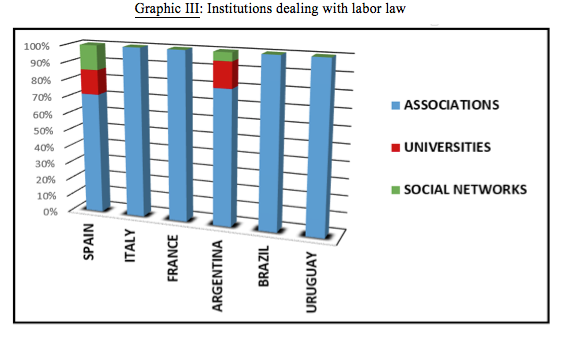
Source: ALJT Workshop on global and regional context, Centro de Estudios Prospectivos (Mendoza, August 2014).
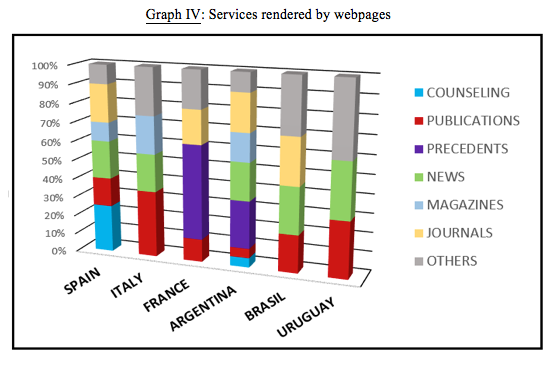
Source: ALJT Workshop on global and regional context, Centro de Estudios Prospectivos (Mendoza, August 2014).
Finally, an activity for the members of the organization was undertaken and it involved an evaluation to find out about the importance of identified Opportunities and Threats.
Upon interpretation of the external context, the following conclusions were drawn:
- ALJT works within a dynamic context with respect to labor legislation. Therefore, the organization may pave the way for the future by means of a proactive participation of its members in research on emerging trends.
- Homogenization of different labor related viewpoints opens up the possibility of providing institutional support to the members and it fosters a sense of belonging to the organization.
- The Association is able to establish relations with international and regional organizations so as to facilitate institutional hierarchy to offer further services to its members.
Some examples of statements derived from the external context analysis are:
- Opportunity: “At a regional level, ALJT is shown as a new alternative for specific international counseling in comparison to other international institutions dealing with the same issues”.
- Threat: “Paradigms shifts related to workers’ rights worldwide may disturb the activities of the ALJT”.
Internal context
Second, the internal context of the ALJT was examined and the following aspects were taken into account:
- Changes in the institutional development of the association.
- Administrative analysis.
- Performance analysis and strategic positioning.
- Resource availability (funding).
In order to gather information, it was necessary to conduct two virtual surveys. The first one was designed to find out the participation in and knowledge about ALJT of the members of the organization and labor law agents in general. The second one was intended to assess Strengths and Weaknesses that the technical team had proposed.
The following aspects should be highlighted:
- ALJT offers a variety of criteria that allows building a qualified critical mass which faces the present reality. This process will improved once a single database is created, contributing to the constant exchange of information.
- ICTs provide alternative means of communication and diffusion of the organizational life of ALJT.
- Due to the development of competences, the association may expand its funding to undertake the activities planned for the year.
Some examples of statements derived from the SWOT analysis are:
- Strength: “On the grounds of Latin American common historical inheritance, ALJT can provide a basis of mutual interest or agreement related to similar problems in each of the countries.”
- Weakness: “ALJT is affected by the lack of enough economic resources and alternative funding mechanisms.”
Strategic synthesis of the external and internal context
Having analyzed the information obtained by SWOT, the following step was to systematize the details by means of the SWOT matrix. By doing this, the Strengths, Weaknesses, Opportunities and Threats were organized, weighed up and it is possible to outline the future strategic actions by the Association.
Graphic V shows the interrelationship established by the crossings of the SWOT tool, making an evaluation from 1 (important) to 4 (very important). The green cells represent maximum values and the red cells show the minimum values.
Analyzing graphic V, the difficulties ALJT may encounter were revealed, taking advantage of the opportunities and protecting from each of the threats. Likewise, it can be exposed the potential characteristic of each strength to exploit the opportunities and/or meet the threats, as well as the weight each weakness has to avoid taking advantage of an opportunity or its ability to face threats.
Graphic V: SWOT matrix

Source: Author´s elaboration based on Ruiz and Vitale, Prospectiva y Estrategia: El caso del Plan Estratégico Vitivinícola 2020 (PEVI) Nº 7.
Construction of scenarios
The following step after the analysis and systematization of the information was the construction of scenarios with the aim of selecting the “forward-looking scenario”, which will lead the present with strategic actions oriented to the desired future.
Within the evaluation of the strategic importance, we may consider:
- Opportunities and Threats:
| O / T |
Statement | Strategic importance2 | Difficulty of exploitation3 |
| O | ALJT presents diversity of opinions and regional experiences. | 6,75 | 4 |
- Strengths and Weaknesses:
| S / W | Statement | Perceived importance4 | Ability to exploit O and face T5 |
| S | ALJT builds a qualified critical mass. | 5,67 | 4 |
Then, it was determined the processes selected by having a higher number of strategic importance and ability of exploitation:
| Statement | Variable |
| ALJT presents diversity of opinions and regional experiences. (O) | Diversity |
| ALJT builds a qualified critical mass. (S) | Development of competences |
After the processes were identified, they were placed on the axes (Graphic VI) in order to determine four alternative scenarios for the ALJT in the near future (SCHWARTZ; 1995).
Graphic VI: Built positioning scenarios.

Source: ALDAO, Juan Pablo, La Planificación Prospectiva Estratégica como medio para el Posicionamiento Institucional. Caso: Asociación Latinoamericana de Jueces del Trabajo. Período 2013-2015.
Some distinctive characteristics of each of the scenarios are described as follows:
- Scenario 1: “Not such an enjoyable way”: situation in which ALJT will develop in the labor market following and enclosing the guidelines suggested by the international labor organisms, especially the International Labor Organization (ILO).
- Scenario 2: “A labor Latin America” (desired): situation in which the association is positioned as a worldwide and regional model for labor law issues. In this scenario, the association stands out with its brand “ALJTrabajo” and it provides the necessary structure for the management of labor issues as well as the alternative international counseling required by Latin American countries.
- Scenario 3: “Dallas Buyers Club” (pessimist): situation that emphasizes ALJT´s crisis and may lead to its dissolution due to the lack of members willing to change the situation. This circumstance may be due to the discredit the association brings and the absence of funding to cover the most basic activities.
- Scenario 4: “Artificial laborism”: situation in which the association may put emphasis on the positive organizational aspects in order to fulfill the requirements of the context. In this stage, ALJT plays the role of accompanying the different Latin American realities, not being able to influence on them in pursuit of a change of the predominant labor conditions.
The selected scenario as a “forward-looking plan” was number 2 “A labor Latin America”, since it reflects the position the association wants to achieve. It is important to highlight that such scenario will serve as a guide of the strategic actions to be done in the present to attain that desired future.
Integration and synthesis of the scenario planning
Once the “forward-looking scenario” was chosen, it was necessary to define the institutional strategy determining the vision, mission, goals, strategies and courses of action.
Graphic VII: Strategic mapping
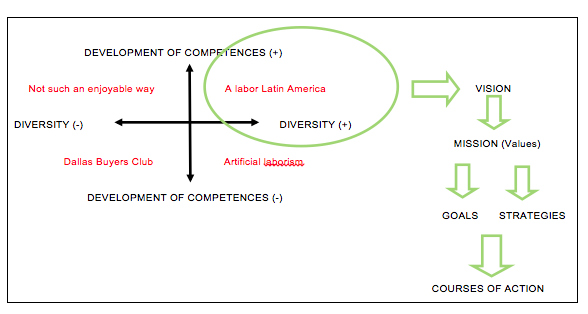
Source: ALDAO, Juan Pablo, La Planificación Prospectiva Estratégica como medio para el Posicionamiento Institucional. Caso: Asociación Latinoamericana de Jueces del Trabajo. Período 2013-2015.
- Vision: defined as a target position to be achieved throughout time. “By 2020, the Asociación Latinoamericana de Jueces del Trabajo will be positioned as a model for worldwide and regional labor issues, teaching, researching and positioning the brand “ALJTrabajo” in legal and academic contexts”.
- Mission: derived from the vision, it represents the dominant values of the Association. “ALJT will be a leading labor organization which will satisfy Latin American workers´ needs and requirements and it will represent its members formally and consistently respecting and protecting their interests as well as their diversity of thoughts and visions”.
- Goals: defined as the inspiration for the actions:
- Positioning ALJT as a local model.
- Representing members in a consistent way.
- Strategies: which allow working towards the goals:
- Creating and promoting the image “ALJTrabajo”.
- Designing a virtual information system.
- Developing competences.
- Courses of action: interpreted as the specific developmental stages to meet the proposed target.
| Strategic goal I: Positioning ALJT as a model for labor law issues. | |
| Courses of action | 1- Developing a marketing program to place the brand «ALJTrabajo» in the labor market. |
| 2- Negotiating international agreements with labor-related organisms. | |
| 3-Designing different methods to encourage the development of competences, for example, offering master’s or postgraduate degrees courses related to specific labor law topics for members and interested parties. | |
| 4- Providing alternative funding sources by means of agreements with international and local associated organizations. | |
| Strategic goal II: Representing members in a consistent way. | |
| Courses of action | 1- Being responsive to members’ wishes and needs by respecting their
diversity of thoughts. |
| 2- Devising a centralized information system with a single database which facilitates the exchange of legal criteria among members. | |
Social validation
With the purpose of implementing the scenario planning, it was essential to communicate and discuss it entirely with the participants who contributed during all the process of formulation and information / knowledge production. In this way, the final elaboration would be done cooperatively such as all the previous process.
In this stage, a virtual survey was conducted in pursuance of validating the scenario planning within the members and interested parties. The following items were dealt with:
- Analysis
- Desired scenario
- Vision
- Mission
- Strategic goals
- Strategies
- Courses of action
Nowadays, some of the developing lines of work include:
- Using methodology of social construction via virtual means.
- Adapting channels of communication.
- Re-arranging funding.
- Developing competences (launching of a virtual diploma programme in 2017).
- Increasing the exchange of information among the members.
- Adopting a critical perspective on mistakes and possibility of correction.
- Acquiring a vision, a mission, goals and strategies, which were not present before.
- Foresight analysis leading to the creation of a space for reflection and exchange of common criteria.
Conclusion
As a result of the constant changes the organizations undergo, it is necessary to have a scenario planning which allows us to identify possible alternatives in the present to build our own future.
Building scenarios simplifies the visualization of the different options ALJT has in order to determine the courses of action in the present.
The triplet (Graphic VIII) “virtuality – social construction of knowledge – convergence between thoughts and actions” was required in order to go through the mentioned process. With the aid of virtuality, as a method of innovation, it proved viable to acquire collective knowledge and to combine ideas/actions with the proactivity of ALJT members.
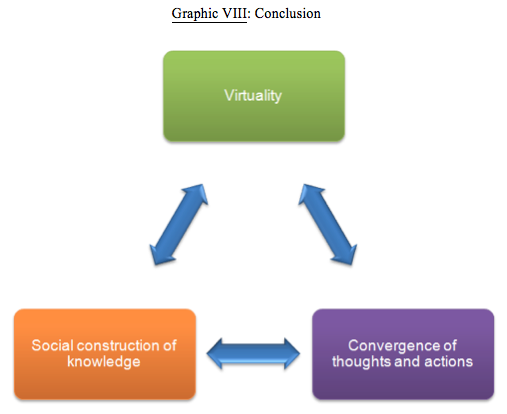
Source: ALDAO, Juan Pablo, La Planificación Prospectiva Estratégica como medio para el Posicionamiento Institucional. Caso: Asociación Latinoamericana de Jueces del Trabajo. Período 2013-2015.
The aim of this work was to show the practical use of the developed tools and to provide guidelines to direct the actions of the Association on its way to maximize the organizational advantages as well as to perform remedial actions and to overcome its disadvantages.
It is relevant to conclude this paper quoting Antonio Machado, a Spanish poet, who said: “…traveler, there is no path, paths are made by walking…». This is precisely the key concept of the research: there is no recipe for success, yet, that is where Scenario Planning lies, building up a unique way for the organization by identifying deviations and strengthening advantages.
REFERENCES
Aldao, J.P. (2016). La Planificación Prospectiva Estratégica como medio para el Posicionamiento Institucional. Caso: Asociación Latinoamericana de Jueces del Trabajo. Período 2013-2015. Argentina: Universidad Nacional de Cuyo.
POSITIONING (on line). In: www.eap.df.gob.mx (Consulted: February 22, 2016).
INSTITUTO POLITÉCNICO NACIONAL–Technical Department (2002). Metodología para el análisis FODA. Dirección de Planeación y Organización.
Martinez Pedrós, D. y Milla Gutiérrez, A. (2005). La elaboración del Plan Estratégico y su implantación a través del Cuadro de Mando Integral. España: Ediciones Díaz Santos.
Medina Vásquez, J. y Ortegón, E. (2006). Manual de prospectiva y decisión estratégica: bases teóricas e instrumentos para América Latina y el Caribe. Chile: Publicación Naciones Unidas.
Ruiz, A. M. y Vitale, J. A. (2011). Prospectiva y Estrategia: el caso del Plan Estratégico Vitivinícola 2020 (PEVI) Nº 7. Argentina: Instituto Nacional de Tecnología Agropecuaria, Ediciones INTA.
Schwartz, P. (1995). La Planificación Estratégica por Escenarios. Revista Cuadernos de Administración (21). Colombia: Universidad del Valle.
Souza Silva, J. Et al. (2001). La cuestión institucional: de la vulnerabilidad a la sostenibilidad institucional en el contexto del cambio de época. Costa Rica, Proyecto ISNAR “Nuevo Paradigma”.
- SWOT = Strengths, Weaknesses, Opportunities and Threats.
- Defined as importance for protecting the organization from identified threats.
- Defined as the difficulty to achieve the identified strategy.
- Defined as the potential characteristic of each strength to exploit the opportunities and/or meet the threats.
- Defined as the weight each weakness has to avoid taking advantage of an opportunity or its ability to face threats.